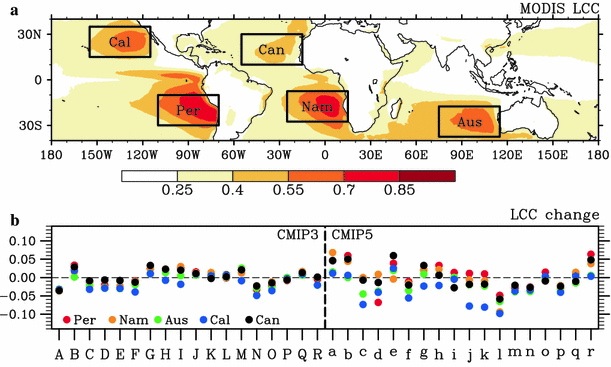
|
||||||||||||||||
|

Climate Feedbacks On the spread of changes in marine low cloud cover in climate model simulations of the 21st centuryGlobal model simulations of the 21st-century climate change differ greatly in how much change they show in marine low cloud cover off the west coasts of continents (see Figure 1). By reflecting incoming solar radiation, marine low clouds play a critical role in regulating the global energy budget. Therefore, credibly representing changes in their coverage is key to producing accurate projections of climate change. In this project, we developed a model to understand the source of the spread among the global climate models associated with phases 3 and 5 of the Coupled Model Intercomparison Project (CMIP3 and CMIP5). The model¡¯s premise is that simulated changes in low cloud cover can be interpreted as a combination of contributions from factors shaping the clouds' large-scale environment. We focused primarily on two factors¡ªthe strength of the inversion capping the atmospheric boundary layer (measured by the estimated inversion strength, EIS) and sea surface temperature (SST). For each given global model, we computed the respective contributions of the two factors by first identifying the sensitivity of low cloud cover to EIS or SST variations, and then multiplying that sensitivity by the climate change signal in EIS or SST. We then attributed the remaining low cloud cover changes to changes in greenhouse gas and aerosol concentrations and other environmental factors. 
Figure 1 We found the heuristic model to be remarkably skillful. SST accounts for nearly two-thirds of the intermodel variance of low cloud cover changes in CMIP3 models, and about half in CMIP5 models (see Figure 2). Of the two factors governing the SST term (the SST increase and the sensitivity of low cloud cover to SST perturbations), the SST sensitivity drives the spread in the SST term and hence the spread in the overall low cloud cover changes. This sensitivity varies a great deal from model to model and is strongly linked to the types of cloud and boundary layer parameterizations used in the models. 
Figure 2 We also estimated EIS and SST sensitivities using observational cloud and meteorological data. The observed sensitivities are generally consistent with the majority of models, as well as with expectations from prior research. Based on the observed sensitivities and the relative magnitudes of simulated EIS and SST changes, the heuristic model predicts low cloud cover will decrease over the 21st century. However, to place a strong constraint, for example on the magnitude of the low cloud cover decrease, will require longer observational records and a careful assessment of other environmental factors producing low cloud cover changes. Meanwhile, addressing biases in simulated EIS and SST sensitivities will clearly be an important step towards reducing intermodel spread in simulated low cloud cover changes. Download the publication (Qu et al. 2014) describing these results in more detail. This study was conducted as part of the Identifying Robust Cloud Feedbacks in Observations and Models Project, a collaboration with Lawrence Livermore National Laboratory supported by the Department of Energy¡¯s Regional and Global Climate Modeling Program (contract DE-AC52-07NA27344). UCLA contributions to the project were led by Xin Qu and Alex Hall, with help from Fengpeng Sun, Florent Brient, and Alexandre Jousse.
|
|||||||||||||||
